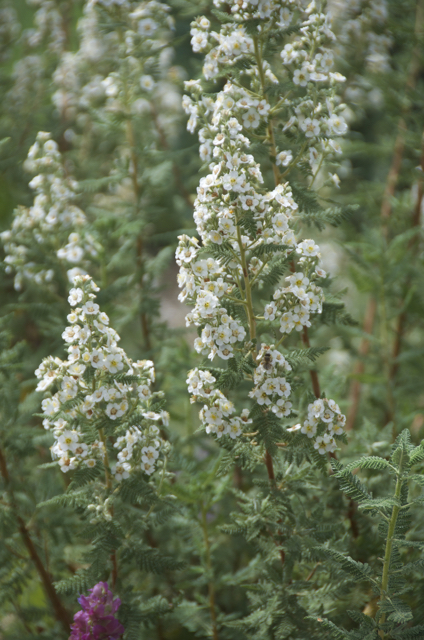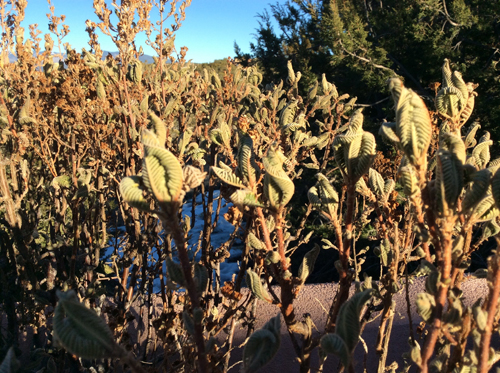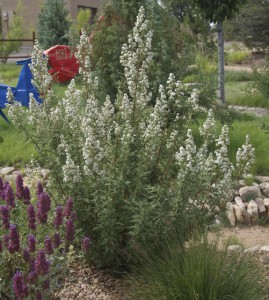Scientific name: Chamaebatiaria millefolium

Fernbush flowers (photo by Janice Tucker)
Common names: fernbush or desert sweet
Family: Rosaceae
By Jeanne Gozigian
The alternate common name of fernbush, desert sweet, gives away the fact that this member of the Rose family is sweetly aromatic. Chamaebatiaria is a monotypic genus of shrub, meaning that is the only representative of a genus containing just one species. More on this intriguing mystery later in this article!
Fernbush is a shrub that grows to 7 feet tall by 7 feet wide, depending on the amount of watering and the zone in which it is planted. It is hardy in zones 5-8, from 4,500 to 7,000 feet in altitude, and should be planted in full sun. It requires moderate watering when planted but can be very drought tolerant when mature. Fernbush can be spectacular as a specimen plant, as well as a hedge or windbreak. It is native to the western states from California through to Arizona and Northern New Mexico’s scrublands, woodlands and forests.

Winter fernbush (Photo by Jeanne Gozigian)
Its Latin specific epithet, millefolium, describes its leaf shape – fern like. The many, fuzzy and sticky leaves are silvery gray in color and distinctly aromatic. The white, 5 petal flowers occur on a cone shaped infloresence and bloom from early to mid summer. The blossoms are very attractive to bees, wasps, and butterflies. It might not be a good idea to plant fernbush next to a frequently used door or heavily trafficked area of your garden. Warn your sting allergic or insect paranoid friends!
The many branched, red shaggy bark of the fernbush shrub provides textural interest year-round for your garden The flower cones can be pruned in autumn but are interesting if left to dry in the winter. In lower zones the plant is evergreen; however, it is deciduous in our region. Look for early new green leaves hiding in the interior of the shrub about February. It is best to purchase plants from a nursery that you prefer. It can be grown from seeds but they must be cold hardened at precise temperatures for specific lengths of time.

New February leaves (by Jeanne Gozigian)

Chamaebatiaria millefolium (Photo by Janice Tucker)
Back to the mystery of Chamaebatiaria millefolium: The first name refers to the genus Chamaebatia, from the ancient Greek – a dwarf bramble of low, sprawling nature. Fernbush’s closest and only relative is Spiraeanthus, native to the lower elevations of the Karatau Mountains and gravel deserts of Kazakhstan. Spiraeanthus is also a monotype. After 2011, plant taxonomists decreed Spiraeoidea should, instead, be classified as Amydaloideae. Spiraeoidea and Amydaloideae are both sub families of the Rose family, thus the connection to Fernbush.
Any guesses as to why these unique plants have occurred so far apart on Planet Earth?
At the Santa Fe Botanical Garden at Museum Hill, examples of fernbush are scattered, some around the Welcome Garden and some by the Xeric Garden.
Sources:
The Plant Book: An Encyclopedia of World Wide Flora
Plants of the Southwest, catalog
US Forest Service
Botanary, The Botanical Dictionary
International Association of Plant Taxonomy


